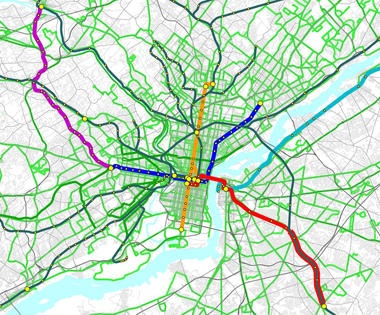
The Office of Modeling and Analysis promotes the orderly growth of the region by providing accurate and timely analysis of transportation and land use. DVRPC forecasts future travel using a well-tested travel modeling process. The heart of this process is our Travel Improvement Model (TIM), a package of computer programs that simulate regional travel behavior. With the model, our engineers and planners use a mathematical representation of the transportation system, along with data on population and economic activity and the principles of supply and demand, to estimate the travel behavior of people in the region. As part of DVRPC's long-range planning efforts, it is vital to have a firm understanding of the region's current travel characteristics in order to produce reasonable forecasts of future highway and transit travel for our studies.
Travel modeling is performed by DVRPC for a number of different purposes. The main purposes are the development of long- and short-range plans and programs, highway traffic studies, air quality conformity demonstrations, Federal Transit Administration (FTA) New Starts programs, and member government transportation studies. The travel forecasting models are guided by Federal Highway Administration (FHWA), Environmental Protection Agency (EPA), and Federal Transit Administration (FTA) guidelines.
While transportation modeling encompasses the majority of duties the office of Modeling and Analysis is responsible for, our work overall will fall under the following three categories:
Transportation Studies & Applications
A variety of transportation, land use, and air quality models are used to perform quantitative analysis and forecasting. This includes highway alternatives analysis, transit alternatives analysis, air quality conformity demonstration, long-range planning, greenhouse gas planning, and other activities.
Model Development
We develop and update a variety of transportation and land use models, including both conventional four-step models and activity-based models.
Data Sources
Transportation related surveys, highway volumes, and transit ridership stats are just some of the various data collected in order to conduct our transportation studies.